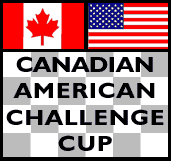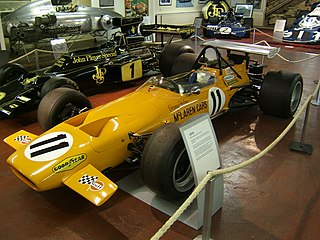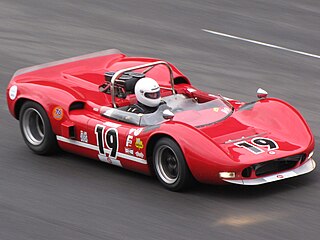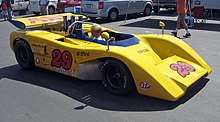
The Ford GT40 is a high-performance mid-engined racing car originally designed and built for and by the Ford Motor Company to compete in 1960s European endurance racing. Its specific impetus was to best Scuderia Ferrari, which had won the prestigious 24 Hours of Le Mans race for six years running from 1960 to 1965. Around 100 cars have been made, mostly as 289 cu in (4.7 L) V8-powered Mk Is, some sold to private teams or as road legal Mk III cars. Racing started in 1964, with Ford winning World Championships categories from 1966 to 1968. The first Le Mans win came in 1966 with three 427 cu in (7.0 L) powered Mk.II prototypes crossing the finish line together, the second in 1967 by a similarly powered highly modified US-built Mk.IV "J-car" prototype. In order to lower ever-higher race top speeds, a rule change from 1968 onwards limited prototypes to 3.0 litre Formula 1 engines; a loophole, however, allowed the private JW "Gulf Oil" team win at Le Mans in 1968 and 1969 running a Mk.I with a 5.0 litre engines.
McLaren Racing Limited is a British motor racing team based at the McLaren Technology Centre in Woking, Surrey, England. The team is a subsidiary of the McLaren Group, which owns a majority of the team. McLaren is best known as a Formula One chassis constructor, the second-oldest active team and the second-most successful Formula One team after Ferrari, having won 189 races, 12 Drivers' Championships, and nine Constructors' Championships. McLaren also has a history in American open wheel racing as both an entrant and a chassis constructor, and has won the Canadian-American Challenge Cup (Can-Am) sports car racing championship. McLaren is one of only three constructors, and the only team, to complete the Triple Crown of Motorsport.

Denis Clive Hulme was a New Zealand racing driver, who competed in Formula One from 1965 to 1974. Nicknamed "The Bear", Hulme won the Formula One World Drivers' Championship in 1967 with Brabham, and won eight Grands Prix across 10 seasons.

Bruce Leslie McLaren was a New Zealand racing driver, automotive designer, engineer and motorsport executive, who competed in Formula One from 1958 to 1970. McLaren was runner-up in the Formula One World Drivers' Championship in 1960 with Cooper, and won four Grands Prix across 13 seasons. In endurance racing, McLaren won the 24 Hours of Le Mans in 1966 with Ford. He founded McLaren in 1963, who have since won nine World Constructors' Championship titles and remain the only team to have completed the Triple Crown of Motorsport.

The Canadian-American Challenge Cup, or Can-Am, was an SCCA/CASC sports car racing series from 1966 to 1974, and again from 1977 to 1987.
Chaparral Cars was a pioneering American automobile racing team and race car developer that engineered, built, and raced cars from 1963 through 1970. Founded in 1962 by American Formula One racers Hap Sharp and Jim Hall, it was named after the roadrunner, a fast-running ground cuckoo also known as a chaparral bird.

The McLaren M23 was a Formula One racing car designed by Gordon Coppuck, with input from John Barnard, and built by the McLaren team. It was a development of the McLaren M16 Indianapolis 500 car. A Ford Cosworth DFV engine was used, which was prepared by specialist tuning company Nicholson-McLaren Engines. This helped push the DFV's horsepower output to around 490 bhp.
Manta Cars was owned and operated by American brothers Brad and Tim LoVette, and was located in Costa Mesa, California, from 1974 to 1986. Manta produced the Manta Mirage, and later produced other component kit cars, including the rear-engined Volkswagen Beetle-based Manta Montage, and the mid-engined Montage-T, which had a custom space frame chassis and used GM X-body V6 drivetrains. The Montage-T recreated the elusive McLaren M6GT.

The Ford P68, also commonly known as the Ford 3L GT or F3L, is a sports prototype racing car model introduced in March 1968. It was designed by Len Bailey, a Ford research engineer, funded by Ford Europe and built by Alan Mann Racing at Weybridge, Surrey, UK. The first competition appearance of a Ford 3L prototype was at the BOAC 500 race at Brands Hatch in Kent. It delivered a good pace, but was criticized for instability at high speeds. It did not finish any of the races in which it was entered, due to mechanical and electrical failures.

The McLaren M2B was the McLaren team's first Formula One racing car, used during the 1966 season. It was conceived in 1965 and preceded by the M2A development car. Designed by Robin Herd, the innovative but problematic Mallite material was used in its construction. The car was powered by Ford and Serenissima engines but both lacked power and suffered from reliability issues.

The McLaren M7A is a Formula One racing car built by McLaren and used in the world championship between 1968 and 1971. After two relatively unsuccessful years of Formula One competition, the M7A was used to score McLaren's first win at the 1968 Belgian Grand Prix.

The Chaparral 2F is a Group 6 sports prototype designed by Jim Hall and Hap Sharp and built under their company Chaparral Cars. Built with the intention to compete in the World Sportscar Championship, it competed in the 1967 season, with a best finish of first at the BOAC 500, driven by Phil Hill and Mike Spence. The 2F, alongside its Can-Am sibling the 2E, had a heavy influence in dictating the direction of Formula One car design in the late 1960s and early 1970s. With the amounts of mechanical grip the car and tires could provide approaching their respective limits, there was a larger emphasis on aerodynamic efficiency with race car designer Colin Chapman quick to include them on his Formula One cars.

The McLaren M14A is a Formula One racing car built and raced by McLaren in the 1970 and 1971 World Championship. A later extension, the M14D featured an Alfa Romeo V8 engine.

The McLaren M6A was a Group 7 prototype race car designed and developed by driver Bruce McLaren, and built by his Bruce McLaren Motor Racing team for their entry in 1967 Can-Am season. As a replacement for the team's M1Bs from 1966, the Chevrolet-powered M6A's improved design earned Bruce McLaren and his team their first of multiple Can-Am championships. After the M6As were replaced by the M8A in preparation for 1968, McLaren and technical partner Trojan–Tauranac Racing developed the M6B which was sold to customers for use in Can-Am as well as other racing series.

The McLaren M12 was an open-cockpit racing car developed by Bruce McLaren Motor Racing in 1969, solely for the purpose of selling to customers in the Can-Am series. The M12 combined elements from two of McLaren's previous efforts, the M6 series and the M8 series.

The McLaren M20 was a sports prototype developed by McLaren for the 1972 season of the Canadian-American Challenge Cup. It served as a replacement for the team's M8Fs, but it later became the final Can-Am design created by McLaren before the team left the series after failing to secure the 1972 championship title. M20s continued to be entered by private teams until the Can-Am championship was canceled at the conclusion of the 1974 season. McLaren driver Denny Hulme won two races during the 1972 season while Scooter Patrick won a single event in 1974 with a privately entered M20.

The Zerex Special was a sports racing car. Originally a Cooper T53 built for the 1961 United States Grand Prix, it was rebuilt for usage in American sports car racing, and featured open-top bodywork. Initially using a 2.75-litre version of the Coventry Climax FPF straight-four engine, it later used a Traco-Oldsmobile 3.5-litre V8. The car won numerous races throughout its four-year career, being driven by drivers such as McLaren and Roger Penske.

The McLaren 650S is a British sports car designed and manufactured by British automobile manufacturer McLaren Automotive. It was announced in February 2014 as a new model, but based on the existing MP4-12C with 25% new parts, and was formally unveiled at the 2014 Geneva Motor Show.

The McLaren M1A, and its derivatives, the McLaren M1B and the McLaren M1C, are a series of mid-engined Group 7 sports prototype race cars built by McLaren, between 1963 and 1968.
The Lola T220, and its evolution, the Lola T222, are Group 7 sports prototype race cars, designed, developed, and built by the British manufacturer and constructor Lola, to compete in the Can-Am championship from the 1971 season. It also took part in the European Interserie championship.




















